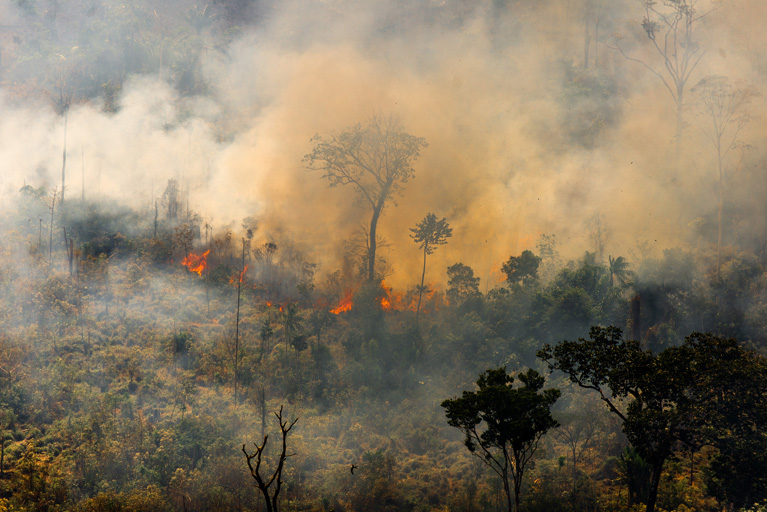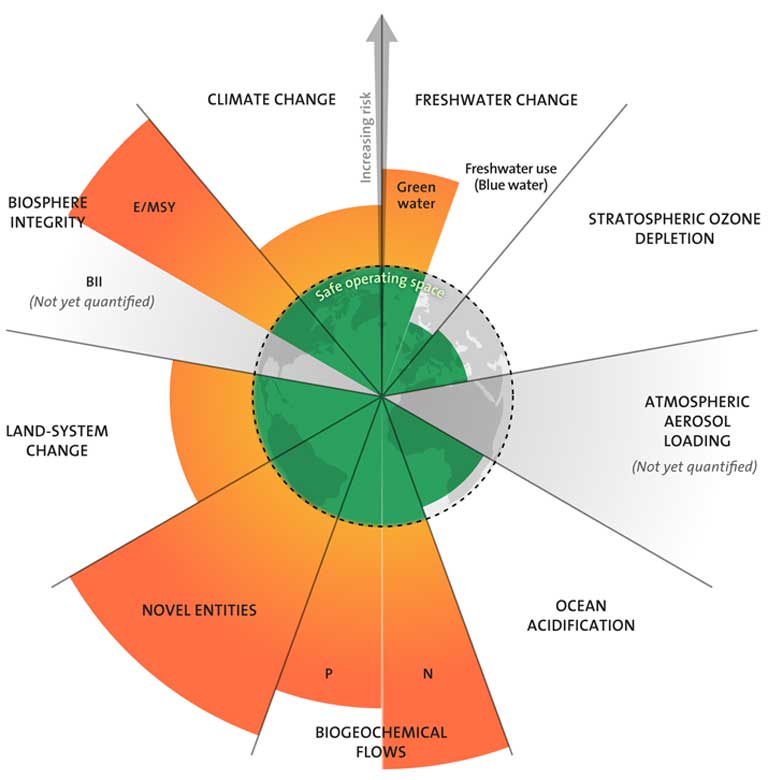Special Reporting Project: Planetary Boundaries
In July 2023, climate change kicked into high gear with record smashing heat waves, storms, floods, droughts and wildfires. These jaw-dropping events come just as the world is about to exceed 1.5° Fahrenheit of warming since the end of the preindustrial era — a threshold beyond which, scientists have warned, we could see catastrophic planetwide impacts.
Unfortunately, this isn’t the only human-caused environmental crisis now on the verge of crossing a dangerous threshold. Scientists have identified, and tried to quantify, nine planetary boundaries (including climate change), the transgression of which could put Earth’s biosphere, the modern world and humanity in peril.
But, while the climate crisis has seen much media attention, the other planetary boundaries have been far less reported — despite the clear and present danger that overshooting them presents. They, too, are proving newsworthy in 2023.
The Mongabay Planetary Boundaries Special Reporting Series, running from August 2023 through March 2024, hopes to remedy that dearth of reporting. We invite potential contributors to pitch us feature stories and news illuminating these nine global threats, shedding light on evolving research, science knowns and unknowns, risk factors, the world’s worst bad actors and viable solutions underway in the public and private sectors.
While the mere thought of nine environmental calamities — each endowed with the complexities, risks and high stakes of climate change — is daunting, your role in reporting on this topic is vital. That’s because helping Mongabay readers recognize these complex interrelated problems now is a first step toward solving these problems in the future.

Background
All life on Earth depends on the global commons: shared resources and Earth life-support systems that ensure a habitable planet (think: the carbon cycle, water cycle, nitrogen cycle, etc.). These vital systems operated naturally and in relative balance for the past 10,000 years, sustaining a vibrant and resilient biosphere and allowing the rise of human society. Today, they continue being critical for providing clean air and water, healthy lands and seas, a stable climate, extraordinary biodiversity and many invaluable ecoservices.
Scientists have carefully assessed the global environment and defined nine planetary boundaries, which, if overshot by human activities, could threaten Earth life-support systems. It is important to understand that this scientific framework is a work in progress, with many unknowns. But evidence makes clear, if we are to avoid further Earth system destabilization, humanity urgently needs to transform its ingrained global food, fuel and materials production, consumption, and disposal processes.
The Mongabay Planetary Boundary Special Reporting Project (SRP) follows up on past Mongabay Planetary Boundary series (hundreds of already published articles are available here). The new SRP seeks to inform the public of the threats posed by transgressing these boundaries and ways to restructure our global economy to help stabilize and strengthen the world’s life-support systems.
The list of nine planetary boundaries to be explored in this series (in order, starting with the most extreme risks as currently assessed by scientists) includes:
- Biogeochemical flows (nitrogen cycle, high risk; phosphorus cycle, high risk)
- Novel Entities (synthetic chemicals and organic pollutants including heavy metals, plastics, radioactive materials, mining waste, etc., high risk)
- Biosphere integrity (functional diversity, high risk; genetic diversity, not quantified)
- Land system change (due to deforestation, agriculture, energy, mining, infrastructure, and other development, increasing risk)
- Climate change (increasing risk)
- Freshwater change (freshwater use/blue water, within safe operating limits; green water — terrestrial precipitation, evaporation and soil moisture — increasing risk)
- Ocean acidification (approaching overshoot of safe operating limits)
- Stratospheric ozone depletion (within safe operating limits)
- Atmospheric aerosol loading (various pollutant particulates; not yet quantified)
Important: As you develop your pitch, please try to see the world through the lens of the various planetary boundaries (PBs). This means being inclusive of, but also moving beyond, climate change — the best known of the nine PBs — to explore how humanity is impacting and potentially overshooting the other boundaries, how Earth system instabilities are affecting people and the world’s habitats, wildlife and plants and what solutions may be.

The nine planetary boundaries and their level of increasing risk as currently evaluated by scientists. Image courtesy of Stockholm Resilience Centre.
Some Suggested Story Topics / Guidelines:
While your pitches needn’t cover the specific themes described below, these are areas in which Mongabay is particularly interested in reporting:
Planetary Boundaries: current state of the science: Feature stories about the nine planetary boundaries utilizing a news hook as an opening to the topic (including current events, newly issued reports, new studies, meetings, as well as government/scientific body/academic/NGO press releases). Stories need to go beyond the news, exploring the basic science of one or more planetary boundaries and/or their interactions; how each Earth life-support system functions, including evaluation of Earth systems’ current state of destabilization and the causes of imbalance and/or offering solutions.
Planetary Boundaries: going deeper: Stories featuring an in-depth look at PBs from a variety of angles, including geographic destabilization hotspots and what we can learn from them (e.g., climate change in the Arctic, nitrogen dead zones in the Gulf of Mexico, ocean acidification in the Pacific region off the California coast) and synergies between various PBs (e.g., how ocean acidification impacts biodiversity, how land-system change impacts both biodiversity and climate change, etc.).
Species-specific PB stories: Series articles can take an individual species approach, looking at one wild species (a keystone plant or animal, charismatic megafauna, endangered species or other), or a group of related species, to see how various PBs are affecting them and how researchers, governments and NGOs or individual activists are responding to conserve those species. Arctic terns, for example, or migratory birds as a group could be a topic. Would be interesting not only to profile animals, but plants too.
Innovative problem-solvers/success stories: Engaging stories that profile and introduce readers to the work of key actors (scientists, conservationists, entrepreneurs, NGOs, companies, engineers, city planners, activists, thought leaders and others) who are actively exploring and implementing approaches to stewardship of critical planetary life-support system processes. These success stories could document current initiatives around the globe, identify opportunities and gaps and help readers understand best practices meant to prevent or forestall the overshooting of planetary boundaries via the implementation of ambitious sustainability programs.
International initiative evaluations: Stories would look at the current status and successes/failings of international cooperative agreements aimed at protecting planetary boundaries (e.g., Paris Accord, Glasgow Forest Declaration, Kunming-Montreal Biodiversity Framework, Montreal Protocol Ozone Depletion Agreement, etc.). Articles could cover institutional PB status reports as they appear throughout 2023-24.
Most egregious bad actors: Profiles of companies, investment institutions, industry associations and others most responsible for, and who most benefit from, producing the largest volumes of destabilizing resource consumption and pollution (carbon, nitrogen, phosphorus, etc.) and the largest areas of deforestation and accompanying biodiversity loss. Stories could look at major players in extractive industries, agribusiness, investment firms, industry supply chains and their contributions to PB overshoot.
Other: Mongabay is open to diverse pitches from existing and new contributors for stories that fulfill the requirements of the Planetary Boundary SRP.
All stories for this series have the potential to be told via narrative (online print stories and photos published on the Mongabay website) as well as via videos (short-form, 1-3 minutes; or long-form, 3-10 minutes) and podcasts, as appropriate. Potential categories of Mongabay videos to accompany articles include explainers, expert interviews, profiles of individual/organization success stories and profiles of egregious actors.
Contributors are also encouraged to maximize readership through republishing and syndication with third-party outlets.
How to Submit Your Pitch
Please submit your pitch here.
Mongabay will make every effort to respond to your pitch request within 30 days after receiving it. Story draft submission date will generally be 4-6 weeks after approval of pitch and acceptance of assignment by contributor, though that is negotiable.
Some potential sources for initial journalistic research:
- Stockholm Resilience Centre (originator of the planetary boundary framework)
- Science-Based-Targets-Network
- Carbon Disclosure Project
- Global Footprint Network
Selected Global networks and organizations working on Planetary Boundary issues:
- Earth System Governance Project
- EAT Initiative
- Future Earth
- Intergovernmental Science-Policy Platform on Biodiversity and Ecosystem Services (IPBES)
- Lancet Countdown on health and climate change
- Local Governments for Sustainability, ICLEI
- Resilience Alliance
- Stockholm International Water Institute (SIWI), Sweden
- The World in 2050: Pathways toward a sustainable future
- UN and UN Agencies focused on the 2030 Agenda
- UN Sustainable Development Solutions Network (SDSN)
- World Benchmarking Alliance
- World Business Council for Sustainable Development, WBCSD
- World Economic Forum